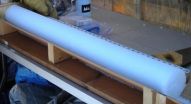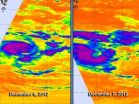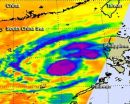(Press-News.org) SAN ANTONIO, TX (December 8, 2012)—Inflammatory breast cancer (IBC) is a very rare and aggressive disease that progresses rapidly and is associated with a very low survival rate. To understand how this type of cancer spreads, it's crucial to characterize the interactions between cancer cells and their 3D environment. Researchers at Fox Chase Cancer Center have developed a novel, 3D culture system that mimics the environment surrounding these cancer cells. This model could be used to test new anticancer drugs capable of inhibiting the spread of IBC tumors.
"The tumor microenvironment plays a pivotal role in tumor development and progression, and it also plays a big role in restricting tumorigenesis," says senior study co-investigator Edna Cukierman, PhD, Associate Professor of Cancer Biology at Fox Chase. "So understanding the interactions between the tumor and the environment will help us to come up with new ways to target the tumor." K Alpaugh, a co-author in this collaborative work, will present the study findings at the 2012 CTRC-AACR San Antonio Breast Cancer Symposium on Saturday, December 8, 2012.
For the study, Cukierman, a tumor microenvironment expert, and her colleagues in the lab of Massimo Cristofanilli, MD, Professor at Fox Chase and a leading expert in inflammatory breast cancer, used tumor-associated stromal cells from patients with advanced IBC to build a 3D structure consisting of cell-derived extracellular matrix—scaffold that provides structural and biochemical support to cells.
After culturing a plethora of established and patient-derived cancer cells in the stromal 3D system, the researchers categorized them into two groups. While some cells showed a significant increase in proliferation and resembled those seen in aggressive tumors, others were more similar to cells in less-aggressive tumors. These two types of cells modified the extracellular matrix in distinct ways, indicating that there is a dynamic interplay between cancer cells and the microenvironment.
Moreover, exposure to the matrix caused all of the cancer cells to increase their expression of the protein epithelial cadherin (i.e., E-Cadherin), whose levels are often elevated in IBC tumors. These findings suggest that the microenvironment may promote the proliferation, growth and invasion of IBC tumors.
"Our system could be used to predict the in vivo behavior of cells and to study the signaling mechanisms that are responsible for tumor-microenvironment interactions in IBC cancer," Cukierman says. "We have some gene candidates that we believe are responsible for the degree of aggressiveness we observe in the 3D model, so we would like to manipulate these genetically using mutants or pharmacologically using inhibitors to block the proteins that we believe are responsible. If that reverses the aggressiveness, it could give us a good hint of what types of targets we could perhaps try to develop and bring to the clinic in the future."
###
Co-investigators on this study include Xiaoshen Dong, Janusz Franco-Barraza, Zhaomei Mu, R. Katherine Alpaugh and Massimo Cristofanilli from Fox Chase.
Fox Chase Cancer Center, part of the Temple University Health System, is one of the leading cancer research and treatment centers in the United States. Founded in 1904 in Philadelphia as one of the nation's first cancer hospitals, Fox Chase was also among the first institutions to be designated a National Cancer Institute Comprehensive Cancer Center in 1974. Fox Chase researchers have won the highest awards in their fields, including two Nobel Prizes. Fox Chase physicians are also routinely recognized in national rankings, and the Center's nursing program has received the Magnet status for excellence three consecutive times. Today, Fox Chase conducts a broad array of nationally competitive basic, translational, and clinical research, with special programs in cancer prevention, detection, survivorship, and community outreach. For more information, visit Fox Chase's Web site at www.foxchase.org or call 1-888-FOX CHASE or (1-888-369-2427). END
Researchers develop novel 3-D culture system for inflammatory breast cancer
2012-12-08
ELSE PRESS RELEASES FROM THIS DATE:
Studies assess genetics, modified treatment to improve outcomes, reduce toxicity
2012-12-08
(ATLANTA, December 8, 2012) – Research identifying genetic factors that affect survival of patients with blood cancers and evaluating the effectiveness of modified treatment strategies to improve outcomes while reducing toxicity will be presented today at the 54th Annual Meeting of the American Society of Hematology (ASH).
While the cancer research community has seen many significant therapeutic advances over the last decade, only recently have investigators identified how patients' individual genetic makeup influences their short- and long-term response to therapy, demonstrating ...
Updated Clinical Results Show Experimental Agent Ibrutinib as Highly Active in CLL Patients
2012-12-08
COLUMBUS, Ohio – Updated results from a Phase Ib/II clinical trial indicates that a novel therapeutic agent for chronic lymphocytic leukemia (CLL) is highly active and well tolerated in patients who have relapsed and are resistant to other therapy.
The agent, ibrutinib (PCI-32765), is the first drug designed to target Bruton's tyrosine kinase (BTK), a protein essential for CLL-cell survival and proliferation. CLL is the most common form of leukemia, with about 15,000 new cases annually in the U.S. About 4,400 Americans die of the disease each year.
Study co-leader Dr. ...
137 new species described by California Academy of Sciences in 2012
2012-12-08
SAN FRANCISCO (December 6, 2012) — In 2012, researchers at the California Academy of Sciences added 137 new relatives to our family tree, enriching our understanding of the complex web of life on Earth and strengthening our ability to make informed conservation decisions. The new species include 83 arthropods, 41 fishes, seven plants, four sea slugs, one reptile, and one amphibian. Specimens ranged from Eviota goby fishes housed in museum collections for more than 30 years (reported in the October 12 issue of Zootaxa), to Trogloraptor cave spiders collected just two years ...
Mayo Clinic IDs genes that predict whether trastuzumab will work for breast cancer patients
2012-12-08
SAN ANTONIO, Texas -- Adding the drug trastuzumab to chemotherapy prevents cancer recurrence and improves survival in a large number of women with early stage HER2-positive breast cancer. But trastuzumab does not stop tumors from returning in about 25 percent of patients — and oncologists haven't been able to identify these women before treatment. This situation may soon change, according to a Mayo Clinic study being presented at the 2012 CTRC-AACR San Antonio Breast Cancer Symposium.
VIDEO ALERT: Video of Dr. Perez is available on the Mayo Clinic News Network.
A team ...
New small molecule inhibitor could be a safe and first-line treatment for metastatic breast cancer
2012-12-08
SAN ANTONIO, TX (December 7, 2012)—Previous research has shown that a family of genes, proteins and enzymes called the uPA system (for urokinase plasminogen activator) plays an active role in different facets of cancer's biology, including tumor cell invasion, the spread of metastases, and the growth of a primary tumor.
Mesupron® is a new small molecule inhibitor, taken as a pill, that inhibits the uPA system. The results from a recent phase II clinical study suggest that the drug could be a safe and first-line treatment that extends progression-free survival for metastatic ...
Green scientists propose safety testing system for development of new chemicals
2012-12-08
PITTSBURGH—A group of scientists from North America and Europe, including Carnegie Mellon University's Terry Collins, has developed a five-tiered testing system that manufacturers can use to ensure that the chemicals and consumer products they produce are free of harmful endocrine disrupting chemicals like BPA or DDT. Their study, "Designing Endocrine Disruption Out of the Next Generation of Chemicals," will be published in the January 2013 issue of the Royal Society of Chemistry journal Green Chemistry, and is currently available online.
Endocrine disrupting chemicals, ...
Greenland ice sheet carries evidence of increased atmospheric acidity
2012-12-08
Research has shown a decrease in levels of the isotope nitrogen-15 in core samples from Greenland ice starting around the time of the Industrial Revolution. The decrease has been attributed to a corresponding increase in nitrates associated with the burning of fossil fuels.
However, new University of Washington research suggests that the decline in nitrogen-15 is more directly related to increased acidity in the atmosphere.
The increased acidity can be traced to sulfur dioxide, which in the atmosphere is transformed to sulfuric acid, said Lei Geng, a UW research ...
NASA casts infrared eye on Southern Indian Ocean's Tropical Cyclone Claudia
2012-12-08
The third tropical cyclone in the Southern Indian Ocean has been renamed Tropical Cyclone Claudia as NASA's Aqua satellite passed overhead.The AIRS instrument on Aqua captured infrared imagery of Claudia over two days that showed the western quadrant is most powerful part of the cyclone.
Aqua flew over Tropical Cyclone Claudia on Dec. 6 at 1959 UTC (2:59 p.m. EST/U.S.) and Dec. 7 at 0811 UTC (3:11 a.m. EST/U.S.). The Atmospheric Infrared Sounder (AIRS) instrument analyzes storms in infrared light, and revealed the temperatures of clouds and sea surface around the storm. ...
NASA infrared data shows Typhoon Bopha re-strengthened in South China Sea
2012-12-08
The deadly typhoon that caused almost 300 deaths in the southern Philippines is making a loop in the South China Sea, and infrared NASA satellite data indicated that Bopha re-intensified.
NASA's Aqua satellite passed over Bopha on Dec. 6 at 1811 UTC (1:11 p.m. EST, U.S.) and the Atmospheric Infrared Sounder (AIRS) instrument aboard captured an infrared look at the storm. The infrared data revealed where the coldest, highest cloud tops were. The coldest cloud tops indicate the strongest storms with the heaviest rain, and AIRS data revealed they surrounded the center of ...
2013 will be a good year, NJIT biz professor forecasts at Chicago Fed Board
2012-12-08
Economic growth will rise to 3 percent in 2013 and 2014, while unemployment will drop to 7.3 percent by December of 2013, NJIT Leir Research Professor William V. Rapp, PhD, http://www.njit.edu/news/experts/rapp.php, told economists and others last week at the annual outlook symposium, http://www.chicagofed.org/webpages/events/eos_series.cfm, sponsored by the Chicago Federal Reserve Bank.
The first Henry J. Leir Professor of International Trade and Business in the NJIT School of Management, Rapp was invited to participate in the annual event which draws the nation's ...


